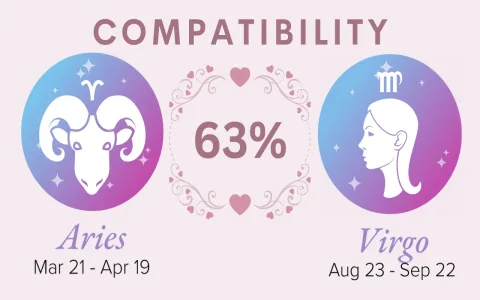The Absolute Chaos We Started With
Man, let me tell you something. When I first hooked up with my Virgo partner, I thought I was hot stuff. I’m a textbook Sagittarius—all big ideas, freedom, throwing things out there, and generally forgetting where I put my keys three seconds ago. She? She remembers the exact date and time I made a promise six months ago and then presents the evidence in a color-coded spreadsheet. It was, frankly, a communication dumpster fire for the first few years.
I genuinely believed that because I was being “honest” and “authentic,” that was good enough. I’d charge in, guns blazing, ready to solve problems with a massive, half-baked solution, maybe interrupting her mid-sentence because I just had a brilliant flash of insight. And she would shut down. Completely. She’d withdraw, not because she was punishing me, but because my scattergun approach felt to her like a lack of respect for the necessary details. I would see her quiet criticism as nitpicking, and she would see my optimism as reckless disregard for reality. We’d fight over stupid stuff—laundry, budgeting, where to eat dinner—but what we were really fighting about was the fundamental disconnect in how we processed and communicated information.
I’m the type who’d say, “Yeah, I’ll clean the garage this weekend,” and she’d expect me to have a list of cleaning products, a projected completion time, and a plan for disposal. When Sunday night rolled around and I’d only moved two boxes, she’d be ready to explode, calmly, of course, with very specific evidence of my failure. And I’d just feel attacked. I’d retort with some generalized philosophical point about prioritizing life over chores, which, naturally, only drove her nuts.
Hitting the Bottom – Why I Had to Actually Learn
Like any good relationship disaster, it takes a crisis to force change. For us, it wasn’t some small squabble; it was when we decided to merge finances and buy a house. I drafted a ridiculously optimistic budget on a napkin during lunch, based mostly on “vibes” and hopeful thinking. I handed it to her triumphantly, expecting praise for my initiative.
What I got instead was a chilling silence. She took the napkin, looked at it, and then tore it up slowly, piece by piece, right in front of me. She stood up and told me, point blank, that if I couldn’t treat her future and our joint life with more respect and precision than a scribble on a paper towel, then maybe we weren’t meant to have a future at all. She packed a bag and left for her sister’s place for a week.
That slammed me harder than any argument we’d ever had. I realized my charming Sag impulsiveness wasn’t charming anymore; it was destructive. I spent that week staring at the shredded napkin, truly understanding that my casual approach to communication was equivalent to refusing to speak her language. It forced me to put my ego aside and actually look at how she needed to receive information to feel secure.
The Practice: Building the Communication Framework
When she came back, I refused to talk about the house or the fight. Instead, I begged her to teach me how to talk to her. This wasn’t counseling; this was a personal infrastructure project. I committed to a system. This is what we built:
- We Instituted “Conflict Office Hours”: I learned that bringing up major disagreements at 10 PM while watching TV was a terrible move. I asked her to dedicate 30 minutes every Sunday afternoon for “Difficult Discussion Time.” This allowed her to mentally prepare her arguments and me to mentally prepare to shut up and listen. No spontaneous ambushes allowed.
- I Started Using Virgo Language: I dumped vague phrases like “I’ll try,” and “eventually.” I replaced them with specifics. Instead of saying, “I’ll fix the squeaky door sometime soon,” I said, “I have blocked out 45 minutes on Saturday at 10:00 AM to lubricate the hinge using WD-40, and I will purchase the product on Thursday.” This created trust.
- The “Three Check” Rule: For any big decision (like the house budget), I developed a system. I drafted my initial thoughts, then I sent her a bulleted draft (Check 1). We discussed it (Check 2). I then revised based on her feedback and sent back the final draft for approval (Check 3). It forced me to slow down and acknowledge the granular reality she lives in.
- I Stopped Dismissing Details: If she pointed out that I left a dish in the sink, I stopped defending myself by discussing global warming. I simply acknowledged the detail and fixed it. I practiced validating her observation, even if I thought it was minor.
What Actually Worked and Where We Landed
It was painful. It felt restrictive for a guy who just wants to run free. But here’s the kicker: this structure actually created more freedom. By addressing her need for precision and planning in the communication process, she relaxed her grip on the smaller day-to-day things. Because I delivered on the important stuff (via her preferred method), she stopped chasing me about the trivial stuff.
We moved past being two incompatible signs who just liked each other, and we became a genuinely functional team. Did it turn me into a Virgo? Hell no. I still lose my keys daily. But I mastered the art of translating my Sag optimism into a format a Virgo can actually digest and trust. We went from screaming at each other about mismatched expectations to calmly scheduling a meeting to revise our quarterly savings goal. It transformed the relationship from a battle of wills into a well-oiled machine.
If you’re an Archer dating an Earth sign, stop trying to use charm to get your way. You have to learn their internal operating system. You have to earn their trust by being predictable and detailed in your dialogue. You practice the steps, you implement the structure, and suddenly, the biggest hurdle—communication—becomes the most solid foundation you’ve ever built.



